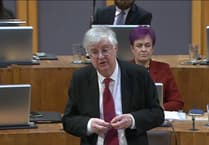Ceredigion residents - fresh from a double digit council tax rise in April – should gear themselves up to be hit in the pocket once again as county council chiefs cook up another up to 14 per cent rise for next year in a bid to balance the books.
Stark warnings of the threats facing Ceredigion County Council finances for next year and beyond were laid out to members of the council’s Corporate Resources Overview and Scrutiny Committee at a meeting on Monday, 23 September.
A bleak document, the council’s Medium Term Financial Strategy, outlined that Ceredigion is facing a budget deficit without savings and tax increases of around £5m each year between now and 2027.
The council had been working on an initial premise of a five per cent council tax for residents, on the back of an 11.1 per cent increase in April which left residents having to find more money to plug council finances while services were stripped.
Committee members, however, heard from Duncan Hall, Ceredigion County Council’s Corporate Lead Officer for Finance and Procurement that a “five per cent council tax rise clearly won’t bridge the gap.”
“Trying to close a £5m gap every year through savings is not a sustainable approach,” he said.
Instead, the financial strategy outlines plans to raise council tax in the county by a minimum of 10 per cent – and even warns that still may not be enough.
Council tax rise options outlined in the report in a bid to bridge a projected budget shortfall of £5.2m in 2025/26 range from a minimum 10 per cent rise, to a 14 per cent rise.
The highest of those options would leave an average Band D property paying an extra £20 a month on top of last year’s inflation-busting rise – leaving the average bill close to £2,400 a year.
Only a 14 per cent rise would, without significant extra Welsh Government funding, plug the budget gap fully, the report outlines.
Previous year’s council tax rises have seen Ceredigion residents now having to pay a council tax bill above the average for Wales.
Ceredigion, while historically below the Wales average, now has the eighth highest council tax in Wales – even before the expected hike again from next April.
In 2020, an average Band D property in Ceredigion paid £1,661 a year to Ceredigion County Council to pay for services such as bin collections, schools and libraries.
If even a 10 per cent rise is instituted by Ceredigion County Council next year, that figure will have risen by more than £600 a year from what residents were paying just five years ago.
It will rise despite what residents get in return in terms of services dwindling each year.
The report “acknowledges that cumulative high increases will impact on local council tax payers in the same way that high inflation bites over a prolonged period.”
The plans to further raise council taxes in the county comes as the county council plans to close schools, introduce car parking charges on Aberystwyth promenade, and slash multiple services in a bid to break even.
The medium term financial strategy outlines a predicted Welsh Government settlement for next year containing just a 0.5 per cent rise to council funding.
“In the absence of any firm indication from Welsh Government and in light of an uncertain economic environment and recent statements from Welsh Government that it is facing significant budget pressures and difficult decisions, it is assumed that annual settlements will increase by 0.5 per cent annually [for the next three years],” the report said.
“A 0.5 per cent increase would still be a real-terms reduction given expected levels of inflation.”
That small predicted funding rise comes after a below average rise of 2.9 per cent was received by Ceredigion County Council last year – not enough to keep services open and reduce the burden on residents.
Council chiefs have called for Welsh Government to completely refresh the way cash is distributed to local authorities in Wales, as rural Wales loses out in a “two tier” funding formula which has left Ceredigion now needing to find a combined £14.3m in savings over the next three years.
Estimated budget shortfalls outline in the council report reach £5.2m in 2025/26, £4.6m in 2026/27 and £4.5m in 2027/28 meaning further double digit tax rises and further deep cuts to services cannot be ruled out even after next year.
For 2025/26, the £5.2m budget gap could be halved by a 10 per cent council tax rise for residents, and brought down to £1.6m if residents are hit with a 12 per cent hike.
Every one per cent that council tax is increased on residents, the council generates around £500,000 in income.
If the council moves ahead with the lowest option of 10 per cent, residents would still be footing a £5m bill while services they pay for are cut.
The report warns that, even with council tax rises, “the ability to deliver the same standard service with less resources is becoming impossible.”
It warns there will be “targeted” budget cuts “where there is political direction to reduce or cease services or functions”.
While Ceredigion council currently looks at savings including the closing of library buildings and schools in a bid to save cash – those moves are unlikely to be enough to meet the budget shortfall in future years.
Massive cash-saving projects including a review of post-16 education in the county which will see sixth forms close are in the pipeline.
A council tax rise of more than five per cent is needed “to ensure that there is sufficient base budget funding to protect key services and core operations,” the report said.
With the estimated £14.3m needing to be found over the next three years, Ceredigion County Council will have slashed budgets in line with a real terms funding decrease since 2012 to the tune of more than £68m.
To date, since 2012, service cuts and tax rises have seen £60.8m worth of savings as Ceredigion council finances are squeezed.
The report says that “savings of £2.8m have already been identified for 2025/26”.
Even with the precarious position, the report rules out using council reserves to prop up services and balance the council’s books “other than in exceptional circumstances.”
“To achieve the level of saving required, particularly if the public finances are going to be under strain for several years, will mean proposals will need to be far reaching,” the report concluded.
“In addition council tax increase considerations will need to take into account the need to ensure that there is sufficient funding to protect key services and core operations.
“This is highly likely to mean a baseline higher than five per cent and closer to or beyond 10 per cent. “Targeted unpalatable budget cuts are likely to be needed which would mean a reduction in council services being delivered rather than continuing to try to deliver the same but with less resources.”
The council’s risk register says that “the reduction of core and external funding will lead to the reduction in service provision in some areas.”




